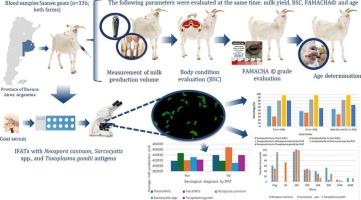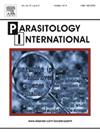阿根廷山羊犬新孢子虫、肌囊虫和刚地弓形虫感染及其与产奶量的关系。
IF 1.9
4区 医学
Q3 PARASITOLOGY
引用次数: 0
摘要
顶复合体原生动物犬新孢子虫、肉囊虫和刚地弓形虫分布在世界各地。山羊感染这些原生动物很常见,但与产奶量的关系尚不清楚。本研究的目的是评价犬奈瑟菌、肉囊菌和弓形虫抗体滴度与羊奶产量的关系。这项研究是在阿根廷布宜诺斯艾利斯省的两个商业奶山羊农场进行的。共评价336只沙南山羊(E1组146只,E2组190只)。计算每次泌乳的总产量,并调整为240泌乳日(毫升)。采集血样,记录年龄、泌乳次数、身体状况、FAMACHA©度。用IFAT检测血清中犬奈瑟菌、弓形虫和弓形虫的抗体,犬奈瑟菌和弓形虫的IFAT检测时间为1:100,肌孢子虫的IFAT检测时间为1:50,每只动物的三种IFAT同时处理至最终滴度。犬奈虫、肉囊虫和弓形虫的总血清阳性率分别为81.8 %(275/336)、85.1 %(286/336)和66.7 %(224/336)。49%的山羊(164/336)对3种ifat血清呈阳性,37.5% %(126/336)对2种ifat血清呈阳性,12.2 %(41/336)对1种ifat血清呈阳性。E1区和E2区分别有80.1和88.4 %和83.1和82.6 %的犬奈菌和肉囊菌的血清阳性率。E1血清弓形虫阳性率(80.1 %)高于E2血清阳性率(56.3% %)。一组16只对弓形虫IFAT滴度较高的山羊产奶量明显低于其他山羊(85.3 L)。在年龄和/或顺序泌乳次数组中,仅对一种、两种或全部三种ifat血清呈阳性和阴性的山羊产奶量无显著差异。我们的研究结果表明,这些原生动物的血清阳性与羊奶产量的相关性很低。本文章由计算机程序翻译,如有差异,请以英文原文为准。

Neospora caninum, Sarcocystis spp. and Toxoplasma gondii infections and their relationship with milk production in goats from Argentina
The apicomplexan protozoa Neospora caninum, Sarcocystis spp. and Toxoplasma gondii are worldwide distributed. Goat infections with these protozoans are frequent, although the relationship with milk production is unknown. The aim of this study was to evaluate and relate the antibodies titers to N. caninum, Sarcocystis spp. and T. gondii with the goat milk production. The study was conducted in two commercial dairy goat farms located in the province of Buenos Aires, Argentina. A total of 336 Saanen breed goats were evaluated (146 goats of E1 and 190 goats of E2). The total production per lactation was calculated and adjusted to 240 lactation days in milliliters. Blood samples obtained and the age, number of lactations, body condition, and FAMACHA© degree were recorded. Sera were tested for N. caninum, Sarcocystis spp. and T. gondii antibodies by IFAT, starting at 1:100 for N. caninum and T. gondii IFATs, and at 1:50 for Sarcocystis spp., and all three IFATs from each animal were processed at the same time to final titer. The overall seroprevalence of N. caninum, Sarcocystis spp. and T. gondii was 81.8 % (275/336), 85.1 % (286/336) and 66.7 % (224/336), respectively. Forty-nine percent (164/336) of goats were seropositive to three IFATs, 37.5 % (126/336) to two and 12.2 % (41/336) to only one. Similar N. caninum and Sarcocystis spp. seroprevalences were observed in E1 (80.1 and 88.4 %) compared to E2 (83.1 and 82.6 %), respectively. A higher T. gondii seroprevalence was detected in E1 (80.1 %) than E2 (56.3 %). A small group of 16 goats with higher IFAT titers to T. gondii, produced significantly less milk (85.3 L) than the rest. No significant milk productivity differences were found in goats seropositive and negative to only one, two or all three IFATs when analyzed within age and/or ordinal lactation number groups. Our results indicate a low association of seropositivity to these protozoans with goat milk production.
求助全文
通过发布文献求助,成功后即可免费获取论文全文。
去求助
来源期刊

Parasitology International
医学-寄生虫学
CiteScore
4.00
自引率
10.50%
发文量
140
审稿时长
61 days
期刊介绍:
Parasitology International provides a medium for rapid, carefully reviewed publications in the field of human and animal parasitology. Original papers, rapid communications, and original case reports from all geographical areas and covering all parasitological disciplines, including structure, immunology, cell biology, biochemistry, molecular biology, and systematics, may be submitted. Reviews on recent developments are invited regularly, but suggestions in this respect are welcome. Letters to the Editor commenting on any aspect of the Journal are also welcome.
 求助内容:
求助内容: 应助结果提醒方式:
应助结果提醒方式:


